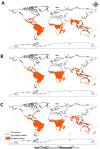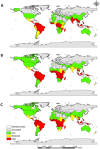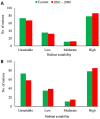Global spatial distribution of Chromolaena odorata habitat under climate change: random forest modeling of one of the 100 worst invasive alien species
- PMID: 37328479
- PMCID: PMC10275895
- DOI: 10.1038/s41598-023-36358-z
Global spatial distribution of Chromolaena odorata habitat under climate change: random forest modeling of one of the 100 worst invasive alien species
Abstract
Anthropogenic activities and global climate change increase the risk of Chromolaena odorata invasion and habitat expansion. To predict its global distribution and habitat suitability under climate change, a random forest (RF) model was employed. The RF model, utilizing default parameters, analyzed species presence data and background information. The model revealed that the current spatial distribution of C. odorata covers 7,892,447 km2. Predictions for 2061- 2080 indicate expansion of suitable habitat (42.59 and 46.30%), reduction of suitable habit (12.92 and 12.20%), and preservation of suitable habitat (87.08 and 87.80%) under the SSP (Shared Socio-economic Pathway) 2-4.5 and SSP5-8.5 scenarios, respectively, in comparison to the present distribution. Currently, C. odorata is predominantly found in South America, with limited presence in other continents. However, the data suggest that climate change will elevate the global invasion risk of C. odorata worldwide, particularly in Oceania, Africa, and Australia. Countries such as Gambia, Guinea-Bissau, and Lesotho, which currently have unsuitable habitats, are predicted to have highly suitable habitats with climate change, supporting the idea that global habitat expansion for C. odorata will occur due to climate change. This study indicates that proper management of C. odorata is crucial during the early invasion phase.
© 2023. The Author(s).
Conflict of interest statement
The authors declare no competing interests.
Figures






References
-
- Pasiecznik N. Chromolaena odorata (Siam weed) CABI Compendium. 2022 doi: 10.1079/cabicompendium.23248. - DOI
-
- Gautier L. Taxonomy and distribution of a tropical weed: Chromolaena odorata (L) R. King & H. Robinson. Candollea. 1992;47:645–662.
-
- Waterhouse, B. M. & Zeimer, O. On the brink’: The status of Chromolaena odorata in northern Australia. In Proceedings of the Fifth International Workshop on Biological Control and Management of Chromolaena odorata, Pretoria, South Africa: ARC-PPRI (eds. Zachariades, C., Muniappan, R. & Strathie, L. W.) 29–33 (Citeseer, 2002).
-
- Lowe, S., Browne, M., Boudjelas, S. & De Poorter, M. 100 of the world’s worst invasive alien species: a selection from the global invasive species database, Vol. 12 (Invasive Species Specialist Group Auckland, 2000).
-
- Zahara, M. Description of Chromolaena odorata LRM King and H. Robinson as medicinal plant: A Review. In IOP Conference Series: Materials Science and Engineering (IOP Publishing).
Publication types
MeSH terms
LinkOut - more resources
Full Text Sources

